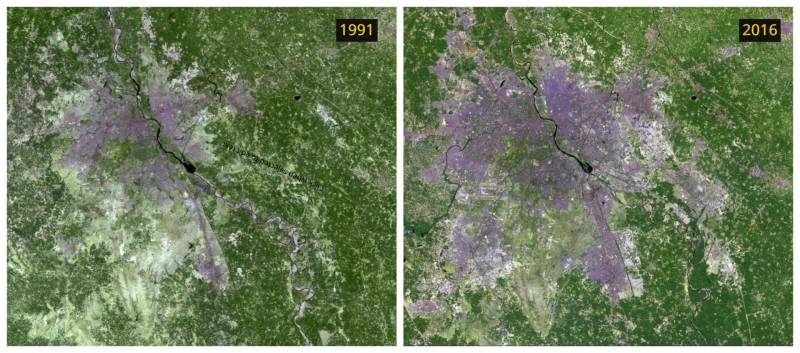Satellite images show how rising urbanisation led to Delhi's air pollution
By Amritha Mohan
New Delhi: In the midst of Delhi’s air pollution emergency, experts suggest that stubble burning may not be the only reason for the prolonged crisis.
Satellite images acquired from NASA for the years 1991 and 2016 show how the increasing urban development that the landlocked city witnessed in 25 years. This, coupled with other geographical factors unique to the city, has contributed to the persistent pollution conundrum in Delhi, according to several environmental analysts.
According to Parveen Kaswan, an Indian Forest Service (IFS) officer, the onset of winter in Delhi is marked by the winds which blow from north-west to east, carrying pollutants from other regions into the city. “The season coincides with temperature inversion: longer the inversion lasts, higher the levels of pollution trapped under it. Since the big cities are in the valley, the pollution has less space to expand,” he tweeted. Added to this is the fact that Delhi’s location does not ensure mixture of air by sea breeze, as can be witnessed in cities like Chennai or Mumbai.
Stubble burning, which is the main culprit behind Delhi’s air problem is not a recent phenomenon. Usually, farmers in Punjab burn the residual straw from paddy fields around late September or early October. However, as per the Punjab Preservation of Subsoil Water Act passed in 2009, paddy could be sown only in June and not earlier than that. This has led to harvesting and stubble-burning happening by the end of October. But by then, the wind had changed directions and moved into Delhi from the north.
Meanwhile, the state governments of Punjab and Haryana have issued challans to farmers for stubble burning. However, it needs to be seen whether the blame actually lies on the government which has shifted harvesting patterns in the state. It is also important to note that stubble burning saw a 30% increase in Punjab this harvest season compared to last year.
The cases of crop residue #fire -- a major air pollutant in #DelhiNCR -- saw a 30 per cent rise in #Punjab after the harvest season this year compared to last year.
Photo: IANS pic.twitter.com/GsZqn0Tt9S
— IANS Tweets (@ians_india) November 2, 2019
Increased mechanisation in agriculture, combined with the city’s expansion in terms of construction and infrastructure are the other contributing factors to air pollution that experts have pointed out. As of now, air quality in Delhi-NCR has worsened even after light rains that occurred yesterday evening and November 3 morning. According to the data gathered at 10 am on November 3, the air quality index (AQI) in the city in many parts still fall under the Hazardous category.